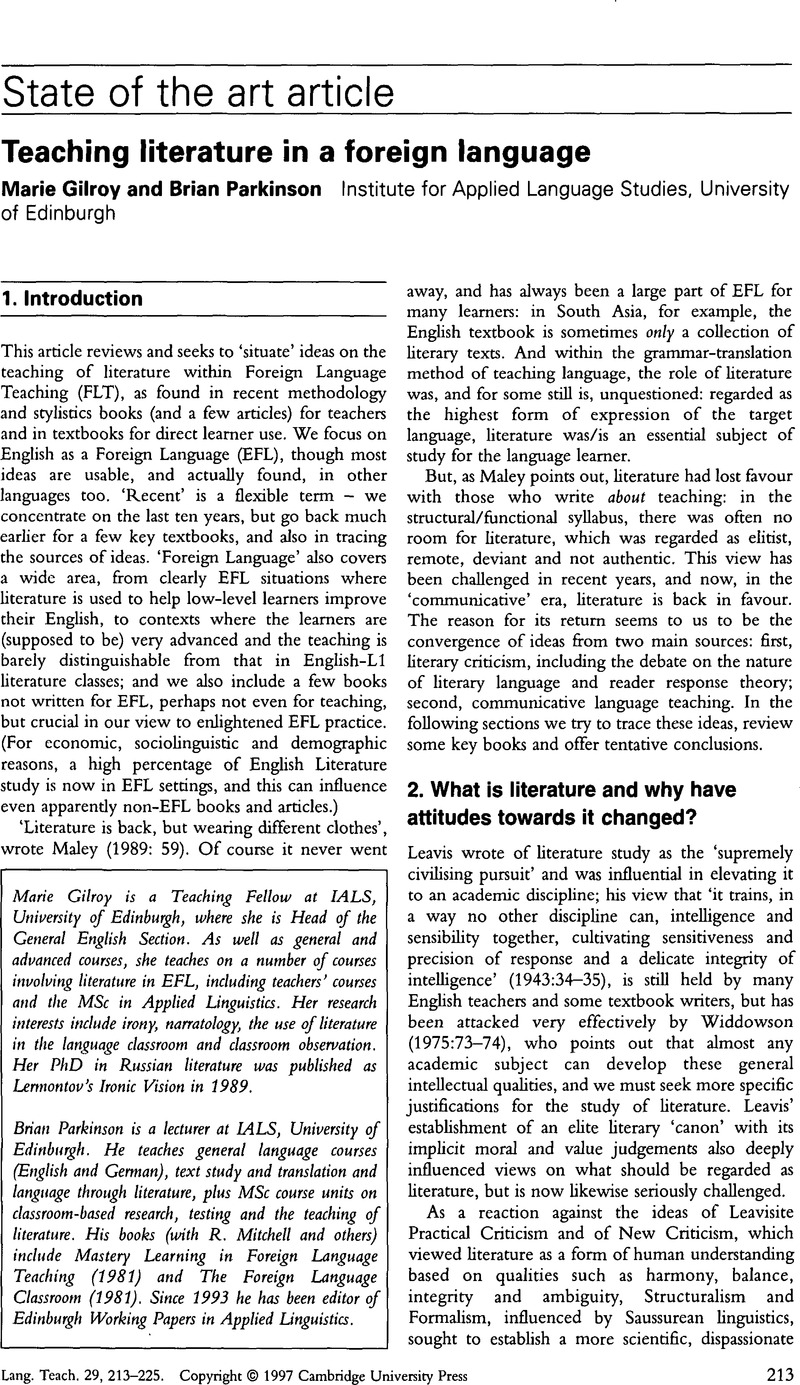Crossref Citations
This article has been cited by the following publications. This list is generated based on data provided by Crossref.
Lasagabaster, David
2000.
El papel de la literatura en la clase de lengua extranjera.
Cultura y Educación,
Vol. 12,
Issue. 3,
p.
67.
Daud, Nuraihan Mat
and
Husin, Zamnah
2004.
Developing critical thinking skills in computer‐aided extended reading classes.
British Journal of Educational Technology,
Vol. 35,
Issue. 4,
p.
477.
Carter, Ronald
2007.
Literature and language teaching 1986–2006: a review.
International Journal of Applied Linguistics,
Vol. 17,
Issue. 1,
p.
3.
Hewitt, Heather
2008.
Literature as language and language as culture: The implications for literature in language teaching - Ronald Carter (2004). Language and creativity: The art of common talk. Abingdon: Routledge. Pp. xiii +255. ISBN 0415234492 (pbk). - Geoff Hall (2005). Literature in language education (Research and Practice in Applied Linguistics). Basingstoke & New York: Palgrave MacMillan. Pp. xii + 278. ISBN 1-4039-4336-2 (pbk). - Amos Paran (ed.) (2007). Literature in language teaching and learning (Case Studies in TESOL Practice). Alexandria, VA: TESOL. Pp. viii + 192. ISBN 193118524-7 (pbk). - Greg Watson & Sonia Zyngier (eds.) (2006). Literature and stylistics for language learners: Theory and practice. Basingstoke & New York: Palgrave MacMillan. Pp. xxiii + 217. ISBN 1-4039-8799-8 (hbk)..
Language Teaching,
Vol. 41,
Issue. 4,
p.
587.
Paran, Amos
2008.
The role of literature in instructed foreign language learning and teaching: An evidence-based survey.
Language Teaching,
Vol. 41,
Issue. 4,
p.
465.
추형화
2009.
Continuum between L2 Language and Literature.
English21,
Vol. 22,
Issue. 4,
p.
201.
Azmi, Mohd Nazri Latiff
2015.
East Meets West: The Reader Response Theory in Thriller Fictions.
Procedia - Social and Behavioral Sciences,
Vol. 174,
Issue. ,
p.
58.
Takahashi, Kazuko
2015.
Literature and Language Learning in the EFL Classroom.
p.
26.
Bloemert, Jasmijn
Jansen, Ellen
and
van de Grift, Wim
2016.
Exploring EFL literature approaches in Dutch secondary education.
Language, Culture and Curriculum,
Vol. 29,
Issue. 2,
p.
169.
Serrano, Aurora Cardona
2017.
Enseeanza Del Espaaol Lengua Extranjera Por Medio De La Literatura (Teaching Spanish as a Foreign Language Through Literature).
SSRN Electronic Journal ,
Badenas Roig, Sonia Rut
2018.
El cuento como recurso didáctico en la enseñanza del francés lengua extranjera.
Revista de Lingüística y Lenguas Aplicadas,
Vol. 13,
Issue. 1,
p.
21.
丁, 宁
2019.
The Status and the Prospects of Using English Drama and Literature in English Teaching.
Overseas English Testing: Pedagogy and Research,
Vol. 01,
Issue. 03,
p.
130.
Calafato, Raees
and
Paran, Amos
2019.
Age as a factor in Russian EFL teacher attitudes towards literature in language education.
Teaching and Teacher Education,
Vol. 79,
Issue. ,
p.
28.
Dumitru, Daniela
2019.
Creating meaning. The importance of Arts, Humanities and Culture for critical thinking development.
Studies in Higher Education,
Vol. 44,
Issue. 5,
p.
870.
Romo-Mayor, Paula
and
Pellicer-Ortín, Silvia
2022.
Revitalising the Role of Literature in the Contemporary EFL Secondary Classroom: A Small-scale Study.
Didáctica. Lengua y Literatura,
Vol. 34,
Issue. ,
p.
15.
Tsang, Art
Paran, Amos
and
Lau, Wilfred W.F.
2023.
The language and non-language benefits of literature in foreign language education: An exploratory study of learners’ views.
Language Teaching Research,
Vol. 27,
Issue. 5,
p.
1120.
Bist, Resham Bahadur
and
Kandel, Rajan Kumar
2024.
Reader Response Approach for Enhancing Literary Comprehension in an EFL Context.
International Journal of Educational Reform,
Nader Sharhan, Asmaa
and
Janfeshan, Kamran
2024.
The Perceptions of Iraqi EFL Preparatory School Teachers about Literature Spots in Iraqi English textbooks.
Cogent Education,
Vol. 11,
Issue. 1,
Krasniqi, Seniha
and
Gjikolli, Lendita
2024.
Literary Works and Technology Aids Inclusion in Foreign Language Learning: Case of Kosovo Students’ Approach.
Journal of Language and Education,
Vol. 10,
Issue. 2,
p.
71.
Shevchenko, Iryna
and
Оrzhitskiy, Igor
2025.
ВИКЛАДАННЯ ЗАРУБІЖНОЇ ЛІТЕРАТУРИ: ПРОБЛЕМА НАСТУПНОСТІ ОСВІТНІХ РІВНІВ У ПІДГОТОВЦІ ФІЛОЛОГІВ У ЗВО УКРАЇНИ.
NEW COLLEGIUM,
Vol. 119,
Issue. 3,
p.
53.


